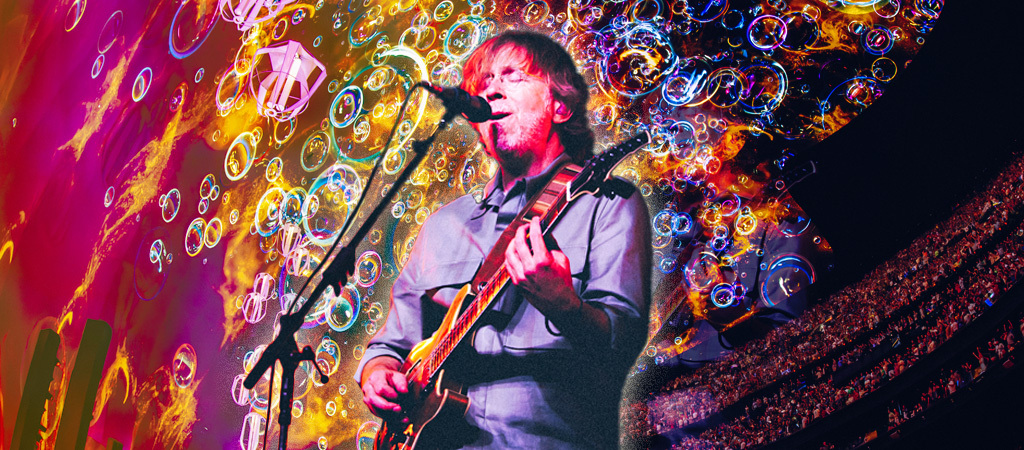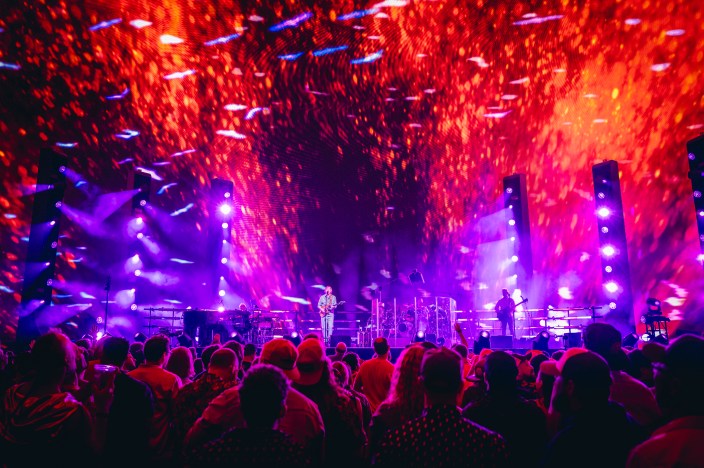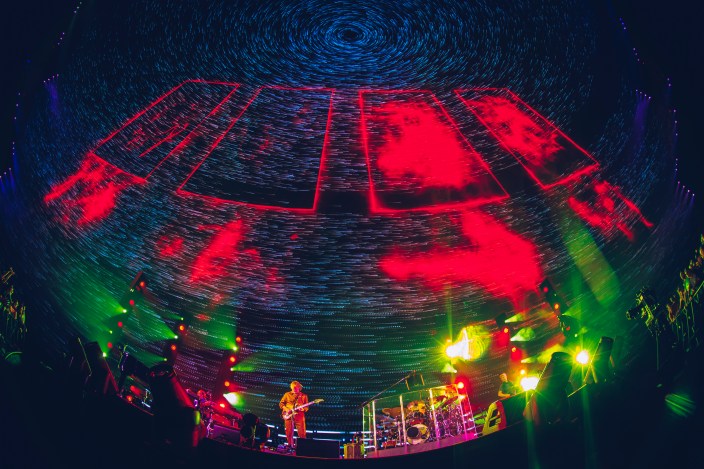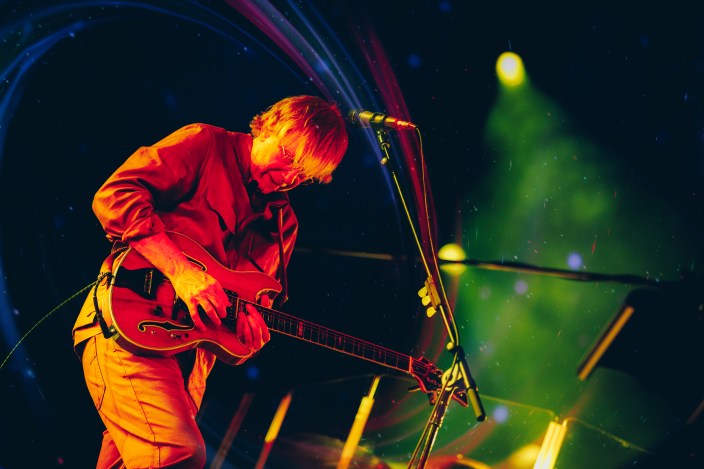… THE GUY SAYS, “I GUESS I HAVEN’T BEEN HERE IN A WHILE” …
I arrived in Las Vegas on Saturday, the morning of 4/20. My Midwestern ass could feel the jet lag as soon as I stepped off the gate and into the airport. But I was determined to overcome fatigue. I pushed the fog out of my brain and started to get mentally primed for that night’s show.
My plan was to avoid missives on social media from the first two shows on Thursday and Friday. But I am a degenerate Twitter addict, so inevitably I was exposed to dozens of tweets and smartphone videos. By the end of Friday, fans deduced that the theme for the Sphere stand related to the natural elements: Thursday was Earth (songs performed included “Leaves,” “Dirt,” and “Sand”) and Friday was water (“A Wave Of Hope,” “Ruby Waves,” “A Song I Heard The Ocean Sing,” etc.) The online consensus seemed to be that Thursday was underwhelming and Friday was a major upgrade, spotlighted by startlingly photo-realistic images of aquatic vistas alternating with a hound the size of Reno licking Sphere’s screen during the multi-part warhorse “You Enjoy Myself.”
A misconception about Phish fans is that they are drug-taking dullards who will happily lap up whatever elongated guitar solo or retina-scratching light show that gets shoved into their faces. That was my impression when I first started investigating Phish bootlegs and going to shows more than a decade ago. At the time, I was burned out with the indie and pop music worlds I was covering as a journalist and critic. I was sick of the constant trend-humping and power jockeying for “hot young thing” status that was endemic among artists and writers alike. In my mind I romanticized a scene that appeared concerned only with good times and tasty jams. I wanted to escape there, like a disenchanted 9-to-5er who decides to hit the road and live out of his van.
Once I entered Phish world, I quickly figured out how wrong I had been. The reality of the jam-band world is that it is more critical than the indie and pop worlds, not less. Way more critical, in fact. Reactions to Phish’s Sphere run were typical — some people (i.e. the fans who lucked into tickets) were ecstatic while many others (i.e. the ones streaming the shows at home) were dismissive about these very expensive concerts staged at a very corporate venue. Was this a new peak for the band or evidence that Phish was lapsing into gimmickry? Personally, I found the cynicism from some corners to be a bit much, though given this moment of hyper-annoying pop-star worship it was also pretty refreshing. Phish fans are not like Taylor Swift stans. They do not demand unquestioning adoration. They’re more like sports fanatics from Philadelphia. Passionate and loyal, but also ready to pelt their heroes with batteries if the moment requires.
After years of Phish immersion, some of that ambient cynicism had seeped into me. My previous Phish shows before Sphere were at Wisconsin’s Alpine Valley Music Theatre in the summer of 2022. I attended all three concerts and found each one more boring than the last. Trey’s post-rehab habit of writing songs centered on the same stock of feel-good buzz words — “love,” “light,” “hope,” “soul” — had finally started to wear on me, especially since the band wouldn’t stop prominently featuring those songs in their setlists. One particular tune, “Ruby Waves,” stood out for having egregiously cringe-y lyrics: “If I could touch the stars with my fingertips / The doors would open all around me / Gonna escape from this prison of lies / And swim in the ocean up above my head.” (Though in fairness to “Ruby Waves,” it was the basis of an all-time jam I saw performed at Alpine three years prior.)
I didn’t excommunicate myself from Phish world after that, but I did go on hiatus for a while. I canceled my LivePhish app and only casually followed new tours via social media. Eventually, the online chatter enticed me back. The accounts I follow were excited about the band’s shows in Mexico this February. The 40-minute “Chalk Dust Torture” from 2/23/24 knocked me on my heels, particularly the second half where it takes a turn into the “evil” sound that the heads yearn for.
The band themselves were energized by the shows. “I thought the Mexico shows [in February] were just crushing in terms of music,” Trey told The Post . “Just the music itself. I know bands always say, ‘Well, our last shows were the best shows,’ and most of the time they’re lying. I’m actually not.”
By then, Trey didn’t have to sell me. I was already back on the train.
… THE BARTENDER SAYS, “WHY THE LONG FACE?” …
Let me get something out of the way quick: I did not take drugs on 4/20 at Sphere while watching Phish. Many people did, but I did not. Unless you count something called the Sphere Mule, which is a cocktail made with tequila and I’m not sure what else that was available at one 200 level bar. I did have a few of those. But no drugs for me! Because I no longer enjoy taking drugs when I am in public — this has been true since I was 32, for reasons too mundane to get into — and because I am a professional rock writer.
As a person who has now seen both legacy rock bands that have played the venue, I am also a veteran Sphere attender. And one thing I have noticed about this building is that you get acclimated to the amazing visuals faster than you might expect. Your standard for what looks cool accelerates even faster than the images on the screen. This obviously works against the venue, and it works against the band.
On Saturday night, the showstopper from a visual and musical perspective was a new song from their forthcoming album Evolve , “Pillow Jets,” which arrived in the first set. The song is pretty good — at least Trey is back to singing about fanciful concepts (silver serpents, pulsating halcyon scepters, etc.) rather than prisons made of lies. Saturday night’s theme was fire, and the band played “Pillow Jets” against stunning images of an alien forest landscape where plants and trees slowly morphed into fireworks. As the band segued into the jam, the forest floor melted into surly waves of molten lava. The images aligned with the controlled chaos of the improvisation for more than 10 minutes. When the band ventured back to the song, the fiery hellscape reshaped backed to the original forest in perfect unison with the music.
A few tracks later, during the ’90s oldie “Taste,” a wall of images culled from Phish’s Live Phish CD artwork created by Jim Pollack stacked the screen like hieroglyphics from 4th century Egypt, along with a 3D crown shape that convincingly hung suspended above the band. It was like Raiders Of The Lost Ark crossed with a vintage head shop from 1998. The effect was spectacular, and it took the visual splendor of what U2 achieved to another level.
But then there were the songs around those songs. For “Mountains In The Mist,” Phish against an authentic facsimile of … mountains in the mist. For “Steam,” the enormous screen was clouded with (you guessed it) steam. Watching this, I found myself thinking, “These images are a little blah.” And then I immediately chastised myself for not appreciating the world-class technical wizardry on display. There’s a goddamn mountain in front of you, you cretin! Don’t be blasé about this! But I had just seen an alien forest turn into molten lava. At Sphere, good can become the enemy of great awfully quick.
When comparing Phish’s Sphere presentation to U2, Trey hinted to the Associated Press that when the screen showed the band members, the images would be “deconstructed,” a more technical way of saying “made to look weirder and cooler.” And Phish did look weirder and cooler during the set one closer “46 Days,” when each member was given their own primary color and then multiplied into endless variations of themselves in a sky-high panorama. In the second set, the half-hour “Fuego” melded front-lit stage lighting that evoked Stop Making Sense along with a kaleidoscope of larger-than-life Trey’s on the big screen. While not as dramatic as the flourishes applied to “Pillow Jets” and “Taste,” these effects nonetheless amounted to a creative reimagining of how bands are presented in spaces like this.
There’s also the matter of sound quality of Sphere, which also was improved upon the U2 run. Mike Gordon’s bass was as clear as I have ever heard it on stage, and it bounced vividly amid Jon Fishman’s virtuosic timekeeping and Page McConnell’s variety of crisply rendered keyboard sounds. Having listened to the recordings streamed on the LivePhish app — I reupped my subscription —I feel like this is the rare instance of the band actually sounding better in the room than they do on tape.
But here’s the thing: When you’re in the room, it’s awfully hard to listen. As my show companion Rob later observed , “Taste” looked incredible but he could not recall a single note that the band played. Inside of Sphere, that big screen owns you. And it compels the audience to experience the show via the second screen of their phones. Thousands of those phones were poised at that screen all night.
A question that occurred to me during U2’s debut at Sphere came back to mind as I turned in that night: Is this another example of tech overwhelming music while ostensibly trying to fix or “save” it? If Sphere is an instrument, Trey was presenting himself as the Les Paul of giant bowling balls. But at what point do the tools replace the music?
Rich Fury
… THE MAN FROWNS AND SAYS, “MY FACE ISN’T LONG, IT’S ONLY 34 MINUTES.”
On Sunday, I prepared for the final night of Phish’s Sphere run in methodical fashion. I felt exhaustion creeping in during Saturday’s second set, which according to my jet lagged body clock didn’t wrap until 1:45 a.m. (It was actually 11:45 p.m. in Sphere time.) I wanted to be strong, so I adhered to the following plan until 4 p.m.: Sleep in, rest, eat a big brunch, rest. Then I started drinking diabetes-inducing canned cocktail drinks in regular intervals until my energy levels were appropriately calibrated.
I enjoyed Saturday’s concert but I hadn’t yet achieved the “mind-blowing” feeling that Trey promised and I was seeking. I purposely planned my trip to include the Sunday night show, as the jam-band maxim “Never Miss A Sunday Show” has proven true in my personal experience. The Sunday show is special because it needs to be — otherwise people would just home after the Saturday show. But in this instance, the Sunday show represented Trey’s last stab (for now) at that 160,000-square foot canvas. It was time to empty the tank.
Heading in, given that the remaining elements were sky/space, it was a safe bet that Phish was going to play “Divided Sky” and their funkified version of the 2001 theme. The former arrived in the first set, and the imagery again was a literal depiction of the titular subject. The clarity of the sky was stunning, but it was overshadowed by the previous number, “Ghost,” in which three Iron Giant -like behemoths constructed with clean neon lines towered over the audience with alternating degrees of whimsy and menace. It was reminiscent of Holmes’ work with Waters on The Wall , though without the acidity of Pink Floyd’s stadium-rock masterwork.
It was breathtaking spectacle. And it’s the only thing I remember from the first set. That’s because the second set proved to be the tour-de-force I was waiting for. And this time it wasn’t about the visuals, though the visuals were of course wondrous. While Saturday and the first set of Sunday engaged my eyes, Sunday’s second set was about the music. It proved to be one of the longest second sets in the band’s history — nearly two hours, with one quarter of that dedicated to an epic 34-minute rendition of “Down With Disease.”
Now, I know for the non-jam band fan — if you are still reading this, god bless — the idea of a 34-minute rendition of any song is a frankly preposterous proposition. But the point of a 34-minute jam aligns with the point of Sphere. You are trying to transport the listener to an unexpected place they would have never found on their own. It’s about taking something you think you know (a song, a concert venue) and transforming it into some magical new thing. In this particular “Down With Disease,” it happens around the 26-minute mark — I know, bear with me! — as the band floats into a woozy space waltz augmented by McConnell’s sci-fi synth tinkering. Then the pace quickens and it sounds like the audience is being rapidly sucked into a black hole, with quick stabs of Psycho -like accents emphasizing the dread.
You can’t write that. And you can’t plan it out for 10 months. Unlike so much at Sphere, it’s something that just happens instantly. In this instance, I don’t remember what was on the screen. I just remember the playing. And that carried through to the other long jams in the set, including a delectable 22-minute version of “Light,” which opened with (what sounded to me anyway) a tease of Led Zeppelin’s “No Quarter.” (Side note: Someone must pay Robert Plant and Jimmy Page $1 billion to play Led Zeppelin songs at Sphere.) A relatively brief nine-minute “2001” preceded it, but the hugeness of “Light” was the first in a series of climaxes that Phish piled on top of each other, like Peter Jackson dealing out ending after ending at the close of The Return Of The King . “Piper” peaked, and then “First Tube” peaked on top of that peak. Then “Slave To The Traffic Light” peaked that peak of a peak.
Here was the most impressive special effect of the entire weekend: This immaculate room, this feat of modern technology, this multi-billion playground for superstars — it made me feel like I was back at Allstate Arena, that dumpy minor-league hockey arena outside of Chicago where I have seen and loved Phish many times, all while trying to avoid the worst bathrooms in arena rock.
That’s what I had been missing. And now I had it. The live music experience felt like home again.
Post navigation



